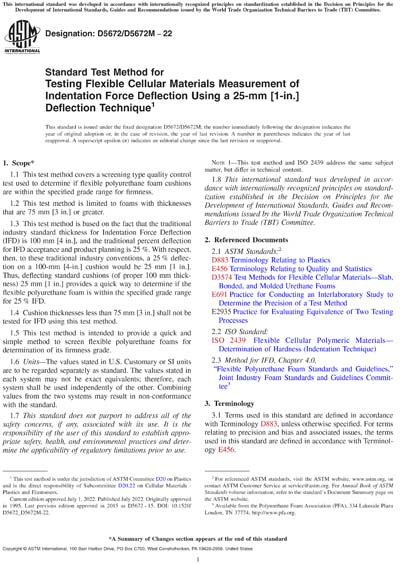Most recent
ASTM D5672/D5672M-22
Standard Test Method for Testing Flexible Cellular Materials Measurement of Indentation Force Deflection Using a 25-mm [1-in.] Deflection Technique
1.1This test method covers a screening type quality control test used to determine if flexible polyurethane foam cushions are within the specified grade range for firmness.
1.2This test method is limited to foams with thicknesses that are 75 mm [3 in.] or greater.
1.3This test method is based on the fact that the traditional industry standard thickness for Indentation Force Deflection (IFD) is 100 mm [4 in.], and the traditional percent deflection for IFD acceptance and product planning is 25 %. With respect, then, to these traditional industry conventions, a 25 % deflection on a 100-mm [4-in.] cushion would be 25 mm [1 in.]. Thus, deflecting standard cushions (of proper 100 mm thickness) 25 mm [1 in.] provides a quick way to determine if the flexible polyurethane foam is within the specified grade range for 25 % IFD.
1.4Cushion thicknesses less than 75 mm [3 in.] shall not be tested for IFD using this test method.
1.5This test method is intended to provide a quick and simple method to screen flexible polyurethane foams for determination of its firmness grade.
1.6Units - The values stated in U.S. Customary or SI units are to be regarded separately as standard. The values stated in each system may not be exact equivalents; therefore, each system shall be used independently of the other. Combining values from the two systems may result in non-conformance with the standard.
1.7This standard does not purport to address all of the safety concerns, if any, associated with its use. It is the responsibility of the user of this standard to establish appropriate safety, health, and environmental practices and determine the applicability of regulatory limitations prior to use.
Note 1:This test method and ISO 2439 address the same subject matter, but differ in technical content.
1.8This international standard was developed in accordance with internationally recognized principles on standardization established in the Decision on Principles for the Development of International Standards, Guides and Recommendations issued by the World Trade Organization Technical Barriers to Trade (TBT) Committee.
Content Provider
ASTM International [astm]






